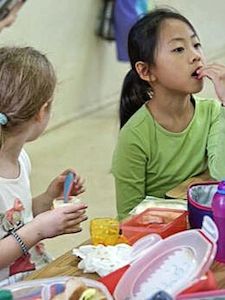How to Win at School Lunchboxes

I daren't calculate how many packed lunches I've made in my lifetime. The fact is that for the best part of two decades I began the day with a roll of lunch wrap and a scowl. My first waking thought every morning was "what will I put in their lunches?". I could have just bought the lunch stuff, pre packaged. Lots of people do – it’s a multibillion dollar industry. But I didn't because not only is much of it junk food, (the kids would have loved it!), it was simply too expensive to waste and we are, truth be told, a family of “lunch leavers".
My brother in law Vic’s older siblings inducted him into their secret lunch dumping club at an early age and nephew El’s collection of uneaten lunches sparked a health alert when spores from mildewed sandwiches nearly blinded someone. My own shameful collection of school lunches were skitched under the bed and periodically hooked out by my outraged mother with the head of the broom. And my Jack, lovely boy, didn't eat a packed lunch for 9 years.
In the end I only packed him a lunch so I don’t get visited by child services. I knew he wouldn't eat it and I regularly saw lots of kids at school dumping complete untouched lunches into the bin with casual familiarity.
My Bella though – always ate hers, loved that I drew faces on her hard cooked egg and when I put avocado in her ham salad sandwich – perhaps she was swapped at birth?
Whether they eat it or not we still have to pack it and filling the lunch with treats won’t automatically make them eat it either. So have a few things you can just snatch and grab, that don’t need spreading or wrapping or stuffing. A healthy lunch is cheap to make and you probably have most of the ingredients already so forget spending up on pre packed treats and prepare your own. Prepare these "snatch and grab" lunch box stuffers on Sunday night so you are set up for the week ahead.
Make individual jellies with fruit in re-useable containers – better for the environment and cheaper than the store-bought ones. Suitable fruits are peaches, pears, banana, apricots and berries – fresh pineapple and kiwifruit can make the jelly runny – something to do with acid I think
Prepare some similar containers of yogurt so you can alternate
Make Home popped corn and pack in snap lock bags
Home baking – mini muffins are ideal as they’re a more appropriate serving size of what is essentially cake and mini’s go such a long way
Home-made muesli bars or some other bar or slice – flapjack made with rolled oats is cheap and tasty and really easy to make
Freeze small scones, savoury or sweet, that can be pulled out of the freezer as required
Muffins small or regular freeze well and will be defrosted by morning tea time – we bake a batch each week and freeze them
You will need a “main event"- sandwich, roll, crackers, sushi, rice salad, left over pasta salad or noodles, piece of quiche or pizza from a previous meal, cold sausage or one of my mighty cheese scrolls…
1. Keep treat foods as treats :
Chippies aren’t everyday snacks, they’re occasional or "treat" foods. Yes the kids will moan, but as parents we get to make the nutritional decision’s, not the kids.
2. Use bribery and corruption :
If they’ve eaten their lunch properly all week, done their homework and learned the spelling words (or whatever is important that week) they can choose a treat to include in the lunch box once a week.
3. Keep it simple :
Adults are attracted to complicated sandwich fillings, kids often aren’t. Particularly if the filling makes the sandwich soggy. Instead of a big fat juicy ham and salad sandwich try a simple ham sandwich, then pack cherry tomatoes and some carrot sticks or snow peas to eat separately.
4. Keep portions small:
Marketers understand that kids love little portions so they package accordingly. Use small reusable containers and bags for kid size snacks. Older kids can stuff a small portion in their pocket to eat while they amble around chatting.
5. Include some of the 5 a day in little portions:
Raisins or dried apricots, grapes or strawberries, baby carrots or bean sprouts. Natural nibbly things. Avoid large apples, whole oranges and bananas – they’re all too often left uneaten as they take too long, interfering with playtime/socialising.
6. Talk about healthy choices :
They’ll begin to notice and talk about who has a healthy lunch and who doesn’t. That doesn’t mean they won’t still moan or “forget" to eat theirs.
7. Don’t disparage spreads :
Peanut butter, honey, mar
- Store:
- Destitute Gourmet
